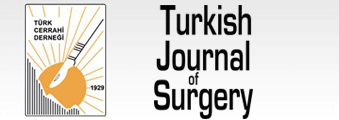
Turkish Journal of Surgery
Yazarlar: Mesut Gül, İbrahim Aliosmanoğlu, Ahmet Türkoğlu, Feyzullah Uçmak, Burak Veli Ülger, Abdullah Oğuz, Ömer Uslukaya
Konular:-
DOI:10.5152/UCD.2012.16
Anahtar Kelimeler:Acute biliary pancreatitis,Cholecystectomy,Endoscopic retrograde cholangiopancreatography,Endoscopic sphincterotomy
Özet: Purpose: This study aimed to investigate the treatments of patients with acute biliary pancreatitis after cholecystectomy. Materials and Methods: Twenty-two patients who were diagnosed with acute biliary pancreatitis and underwent cholecystectomy were analysed retrospectively. The patients' demographic characteristics, severity of disease, elapsed time since cholecystectomy, whether endoscopic retrograde cholangiopancreatography and endoscopic sphincterotomy were performed, surgical intervention, duration of hospital stay, and mortality were recorded. Results: The average age of the 22 patients was 60.14±16.4 (21- 86), and the female to male ratio was 14:8. The average elapsed time since cholecystectomy was 81.7 (6-240) months. In 18 patients, stones and mud were detected in the choledoch duct with endoscopic retrograde cholangiopancreatography, with no factors identified in 4 patients. While 14 of these 18 patients were treated successfully with stone extraction and endoscopic sphincterotomy, endoscopic retrograde cholangiopancreatography did not succeed in 4 patients. In 3 of 4 patients, in whom stones were detected but failed to be extracted, choledoch duct exploration was carried out with open surgery. Mortality developed in one patient. Average hospital stay, with the exception of the deceased patient, was 8.5±3.5 days. Conclusion: Some choledoch duct stones can remain asymptomatic for an extended period after cholecystectomy. However, some cause acute pancreatitis ending in mortality after several months or even years. Endoscopic retrograde cholangiopancreatography and endoscopic sphincterotomy are the standard methods of treatment. Patients in whom endoscopic retrograde cholangiopancreatography and endoscopic sphincterotomy have failed, can be treated with choledoch duct exploration with open surgery and laparoscopic surgery.